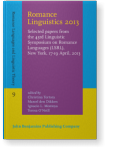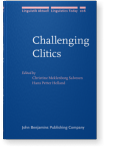Diego Pescarini
List of John Benjamins publications for which Diego Pescarini plays a role.
2018 Chapter 13. Stressed enclitics are not weak pronouns: A plea for allomorphy Romance Languages and Linguistic Theory 14: Selected papers from the 46th Linguistic Symposium on Romance Languages (LSRL), Stony Brook, NY, Repetti, Lori and Francisco Ordóñez (eds.), pp. 231–244 | Chapter
The paper compares a morphophonological and a syntactic approach to stress shift and enclisis/proclisis asymmetries. The former analysis envisages the co-occurrence of multiple allomorphs with the same featural content, which are distributed in accordance with phonological rules. The latter… read more
2018 Chapter 8. Concealed pseudo-clefts? Evidence from a Lombard dialect Structuring Variation in Romance Linguistics and Beyond: In honour of Leonardo M. Savoia, Grimaldi, Mirko, Rosangela Lai, Ludovico Franco and Benedetta Baldi (eds.), pp. 121–131 | Chapter
This paper focuses on the syntax of clefts in the Lombard dialect of Comun Nuovo (Bergamo). In this dialect, clefts are highly constrained (in particular, they are ungrammatical in questions) and, in the contexts where clefts and pseudo-clefts alternate, the distinction between the two is often… read more
2016 The X0 syntax of “dative” clitics and the make-up of clitic combinations in Gallo-Romance Romance Linguistics 2013: Selected papers from the 43rd Linguistic Symposium on Romance Languages (LSRL), New York, 17-19 April, 2013, Tortora, Christina, Marcel den Dikken, Ignacio L. Montoya and Teresa O'Neill (eds.), pp. 321–339 | Article
This contribution focuses on the morphosyntax of third person dative clitics in Gallo-Romance. The first part addresses the morphology of clitic elements: in GalloRomance, third person datives can be expressed by an etymological form li(s) deriving from Lat illi(s) or by various kinds of… read more
2015 On the emergence of two classes of clitic clusters in Italo-Romance Romance Linguistics 2012: Selected papers from the 42nd Linguistic Symposium on Romance Languages (LSRL), Cedar City, Utah, 20-22 April 2012, Smith, Jason and Tabea Ihsane (eds.), pp. 171–184 | Article
This contribution deals with the make-up of Italo-Romance clitic sequences. Building on Kayne (1994), I will argue that some clitic combinations are clusters in which one clitic is left-adjoined to the other, while others are split sequences formed by adjacent clitic heads. In particular, on the… read more
2013 Clitic clusters in early Italo-Romance and the syntax/phonology interface Challenging Clitics, Meklenborg Salvesen, Christine and Hans Petter Helland (eds.), pp. 255–282 | Article
This paper deals with the morpho-phonology of Italo-Romance clitic clusters. It argues that morpho-phonological processes (i.e. apocope, prosthesis, etc.) are sensitive to both the syntactic make-up of clitic clusters and their prosodic structure. The first part of the paper aims to support the… read more




